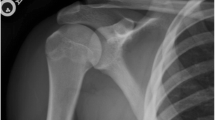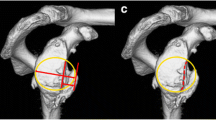Abstract
The glenoid labrum is a peripherally elevated part of the glenoid rim that consists mostly of fibrous tissue. It plays an important role in the stabilization of the glenohumeral joint. The normal anatomy of the glenoid labrum varies widely and it is difficult to distinguish between normal conditions and a pathological finding. Good knowledge of the anatomy of the glenoid labrum is essential to judge clinical, radiographic and arthroscopic findings. Use of magnetic resonance arthrography (Arthro-MRI) of the shoulder is the best method to evaluate pathologic conditions of the glenoid labrum. The status of the labrum in anteroinferior, posterior and multidirectional instability of the shoulder will be shown in this article by Arthro-MRI and arthroscopic views.
Zusammenfassung
Das Labrum glenoidale ist sowohl für die Funktion der Schulter als auch für ihre Stabilität von großer Bedeutung. Das Labrum glenoidale gehört zu den statischen Stabilisatoren der Schulter und trägt wesentlich dazu bei, das knöcherne Ungleichgewicht zwischen Humeruskopf und Gelenkpfanne auszugleichen. Um zwischen einem Normalbefund, einer anatomischen Variante und einem pathologischen Befund unterscheiden zu können, ist die Kenntnis der Anatomie des Labrum glenoidales grundlegend. Das periartikuläre Fasersystem, welches das Labrum glenoidale bildet, stabilisiert zum einen das Glenohumeralgelenk, zum anderen bildet es die Verbindung zwischen der Cavitas glenoidalis und der angrenzenden Kapsel, inklusive den glenohumeralen Bändern. Den Goldstandard in der Diagnostik von Verletzungen des Labrum glenoidale stellt die MRT-Untersuchung mit intraartikulärer Kontrastmittelgabe (Arthro-MRT) dar. Die unterschiedlichen Läsionen des Labrum glenoidalis bei anteroinferiorer, posteriorer und multidirektionaler Instabilität sowie bei SLAP-Läsionen werden anhand von Fallbeispielen mit Arthro-MRT Bildern und arthroskopischen Bildern veranschaulicht.
Similar content being viewed by others
Literatur
Wilk KE, Arrigo CA,Andrews JR (1997) Current concepts: the stabilizing structures of the glenohumeral joint. J Orthop Sports Phys Ther 25(6):364–379
Saha AK (1971) Dynamic stability of the glenohumeral joint. Acta Orthop Scand 42(6):491–505
Boardman ND, et al. (1996) Tensile properties of the superior glenohumeral and coracohumeral ligaments. J Shoulder Elbow Surg 5(4):249–254
Barthel T, et al. (2003) Anatomy of the glenoid labrum. Orthopade 32(7):578–585
Huber WP, Putz RV (1997) Periarticular fiber system of the shoulder joint. Arthroscopy 13(6):680–691
Lippitt S, Matsen F (1993) Mechanisms of glenohumeral joint stability. Clin Orthop Relat Res 291:20–28
Snyder SJ, et al. (1990) SLAP lesions of the shoulder. Arthroscopy 6(4):274–279
Ilahi OA (2004) Anatomical variants in the anterosuperior aspect of the glenoid labrum. J Bone Joint Surg Am 86-A(2):432–433; author reply 433
Pfahler M, et al. (2003) Age-related changes of the glenoid labrum in normal shoulders. J Shoulder Elbow Surg 12(1):40–52
Cooper DE, et al. (1992) Anatomy, histology, and vascularity of the glenoid labrum. An anatomical study. J Bone Joint Surg Am 74(1):46–52
Waldt S, et al. (2005) Anterior shoulder instability: accuracy of MR arthrography in the classification of anteroinferior labroligamentous injuries. Radiology 237(2):578–583
Robinson G, et al. (2006) Normal anatomy and common labral lesions at MR arthrography of the shoulder. Clin Radiol 61(10):805–821
Flannigan B, et al. (1990) MR arthrography of the shoulder: comparison with conventional MR imaging. AJR Am J Roentgenol 155(4):829–832
Beltran J, et al. (1997) Glenohumeral instability: evaluation with MR arthrography. Radiographics 17(3):657–673
Escobedo EM, et al. (2007) Increased risk of posterior glenoid labrum tears in football players. AJR Am J Roentgenol 188(1):193–197
Gohlke F, Hedtmann A (2002) Schulter, In: Wirth CJ (ed) Orthopädie und Orthopädische Chirurgie, Stuttgart, New York: Thieme
Weber BG, Simpson LA, Hardegger F (1984) Rotational humeral osteotomy for recurrent anterior dislocation of the shoulder associated with a large Hill-Sachs lesion. J Bone Joint Surg Am 66(9):1443–1450
Rowe CR, Sakellarides HT (1961) Factors related to recurrences of anterior dislocations of the shoulder. Clin Orthop 20:40–48
Resch H, Wanitschek P, Sperner G (1989) The technic of the Bankart operation, A modified reinsertion technic. Unfallchirurg 92(8):407–413
Scheibel M, et al. (2006) Postoperative subscapularis muscle insufficiency after primary and revision open shoulder stabilization. Am J Sports Med 34(10):1586–1593
Scheibel M, et al. (2007) Structural integrity and clinical function of the subscapularis musculotendinous unit after arthroscopic and open shoulder stabilization. Am J Sports Med 35(7):1153–1161
Cicak N, et al. (2005) Arthroscopic extracapsular plication to treat multidirectional instability of the shoulder. Arthroscopy 21(10):1278
Bradley JP, et al. (2006) Arthroscopic capsulolabral reconstruction for posterior instability of the shoulder: a prospective study of 100 shoulders. Am J Sports Med 34(7):1061–1071
Carreira DS, et al. (2006) A prospective outcome evaluation of arthroscopic Bankart repairs: minimum 2-year follow-up. Am J Sports Med 34(5):771–777
Kim SH, et al. (2004) Arthroscopic capsulolabroplasty for posteroinferior multidirectional instability of the shoulder. Am J Sports Med 32(3):594–607
Tischer T, Vogt S, Imhoff AB (2007) Arthroscopic stabilization of the shoulder with suture anchors with special reference to the deep anterior-inferior portal (5, 30 o'clock). Oper Orthop Traumatol 19(2):133–154
De Simoni C, Imhoff AB (2000) Ein neuer inferiorer (5:30-Uhr-) Zugang für die arthroskopische Reparation des Bankart-Schadens. Arthroskopie 13:217–219
Jerosch J, Castro WH (1990) Shoulder instability in Ehlers-Danlos syndrome. An indication for surgical treatment? Acta Orthop Belg 56(2):451–453
Beighton PGR, Bird H (1984) Bandlaxität: Messmethoden und Epidemiologie. Orthopäde 13:19–24
Maffet MW, Gartsman GM, Moseley B (1995) Superior labrum-biceps tendon complex lesions of the shoulder. Am J Sports Med 23(1):93–98
Imhoff AB, et al. (2000) Superior labrum pathology in the athlete. Orthopade 29(10):917–927
Author information
Authors and Affiliations
Corresponding author
Rights and permissions
About this article
Cite this article
Paul, J., Schöttle, P.B. & Imhoff, A.B. Die Pathologie des Labrum glenoidale. Obere Extremität 2, 143–149 (2007). https://doi.org/10.1007/s11678-007-0055-0
Received:
Accepted:
Issue Date:
DOI: https://doi.org/10.1007/s11678-007-0055-0




